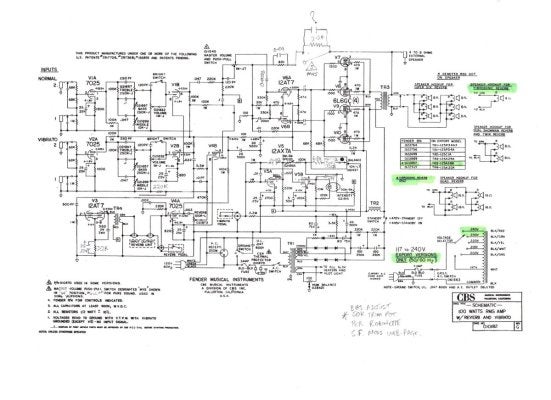shinbones_jr
TDPRI Member
I recently acquired a non-working 1974 Vibrosonic Reverb and brought it back to life with new electrolytic caps throughout and new (freshly reconed) EVM-15L speaker. It now works fine... with all voltages correct(ish) per the schematic and everything else doing what it should. I love it, but find it sounds very ice-picky, especially at higher volumes.
I've made a few of the mods described by @robrob at his awesome website. These include adding adjustable bias, slowing the tremolo and reducing tremolo tick. I'll attach a schematic including my all mods below.
Mine is the push-pull master vol variant and before I saw @CoolBlueGlow's recent thread on taming the crappy pull-for-distortion function, I decided to delete that entire circuit and utilise the pull-switch for optional reduced NFB. So now the amp has the stock NFB circuit (820ohm w/100ohm shunt) when the switch is pulled, and light NFB (2.2k+820ohm w/100 ohm shunt) when the switch is pushed in.
To tame the ice-pick, I've put a 0.01uF cap across the stock 820ohm NFB resistor. I like what that does to the tone with the stock NFB setting but when I push the MV in for reduced NFB there's still too much ice-pick.
So I figure I need to add a cap across the 2.2k NFB resistor to let the ice-pick highs pass, but I can't work out what value cap I should put in parallel with the switchable 2.2k resistor to get the same frequencies bypassing the resistor as I'm getting from the the 0.01uF/820ohm combo. At this point my ambitions exceed my theoretical knowledge so I'm asking for help. Can anyone please tell me what value cap I should add where I've put the '?' on my attached schematic?
FWIW, the other half of the DPST MV switch is now spare and could be used if that helps.
With thanks,
Scott

I've made a few of the mods described by @robrob at his awesome website. These include adding adjustable bias, slowing the tremolo and reducing tremolo tick. I'll attach a schematic including my all mods below.
Mine is the push-pull master vol variant and before I saw @CoolBlueGlow's recent thread on taming the crappy pull-for-distortion function, I decided to delete that entire circuit and utilise the pull-switch for optional reduced NFB. So now the amp has the stock NFB circuit (820ohm w/100ohm shunt) when the switch is pulled, and light NFB (2.2k+820ohm w/100 ohm shunt) when the switch is pushed in.
To tame the ice-pick, I've put a 0.01uF cap across the stock 820ohm NFB resistor. I like what that does to the tone with the stock NFB setting but when I push the MV in for reduced NFB there's still too much ice-pick.
So I figure I need to add a cap across the 2.2k NFB resistor to let the ice-pick highs pass, but I can't work out what value cap I should put in parallel with the switchable 2.2k resistor to get the same frequencies bypassing the resistor as I'm getting from the the 0.01uF/820ohm combo. At this point my ambitions exceed my theoretical knowledge so I'm asking for help. Can anyone please tell me what value cap I should add where I've put the '?' on my attached schematic?
FWIW, the other half of the DPST MV switch is now spare and could be used if that helps.
With thanks,
Scott



